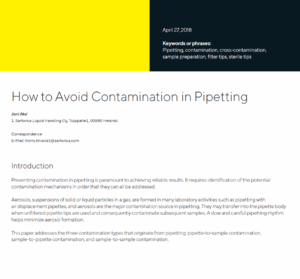Contamination during pipetting is one of the leading causes of compromised data in both research and regulated laboratory settings. To ensure accuracy and reproducibility, it’s essential to understand how contamination occurs and how to prevent it.
This application guide outlines the primary mechanisms of pipetting-related contamination and offers actionable strategies to minimize risk. Whether you’re working with sensitive assays, regulated testing protocols, or high-throughput workflows, this guide helps strengthen your contamination control practices.

Inside this guide, you’ll learn:
- The three key contamination types in pipetting:
- Pipette-to-sample contamination
- Sample-to-pipette contamination
- Sample-to-sample contamination
- How aerosols act as a major contamination source
- The role of pipetting speed, rhythm, and tip selection in minimizing aerosol formation
- Why filtered tips and proper technique are critical to preventing internal pipette contamination
Who should use this guide?
- Contract testing laboratories operating under ISO, GLP, or GMP guidelines
- QA/QC professionals managing contamination-sensitive workflows
- Lab managers training teams on contamination prevention
- Scientists handling molecular, microbiological, or low-volume liquid samples
Get your copy now!
By addressing the full range of contamination risks—mechanical, procedural, and environmental—this guide supports cleaner, more consistent results in every pipetting task.
